CROSSLEY VEHICLES TODAY
1935 Regis 10 Saloon
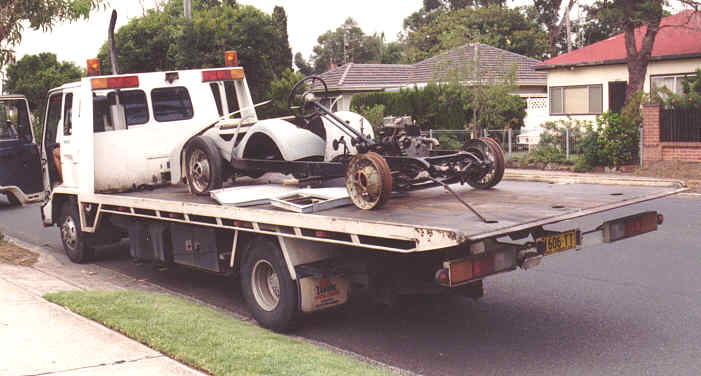
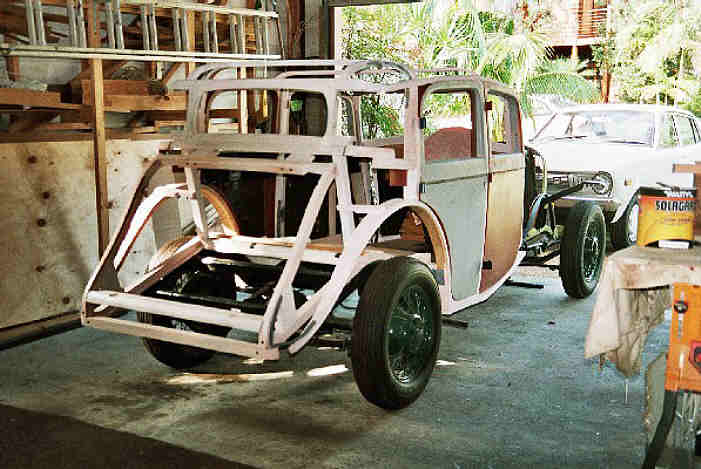
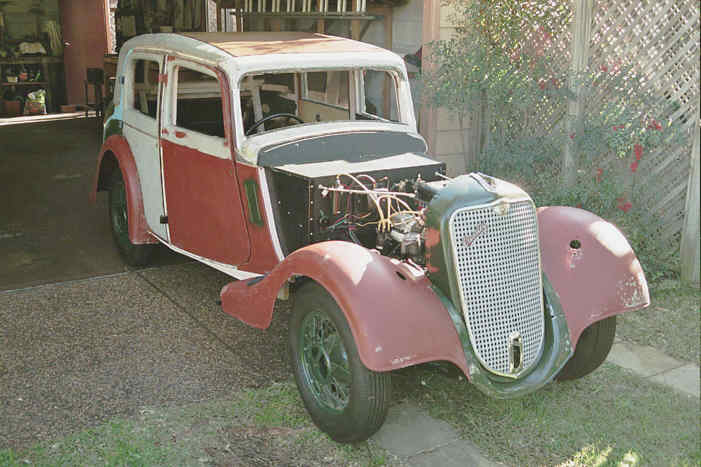
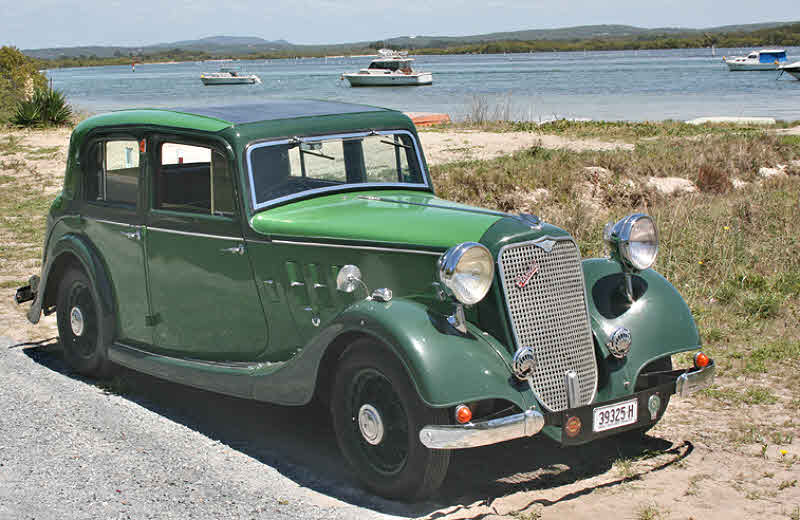
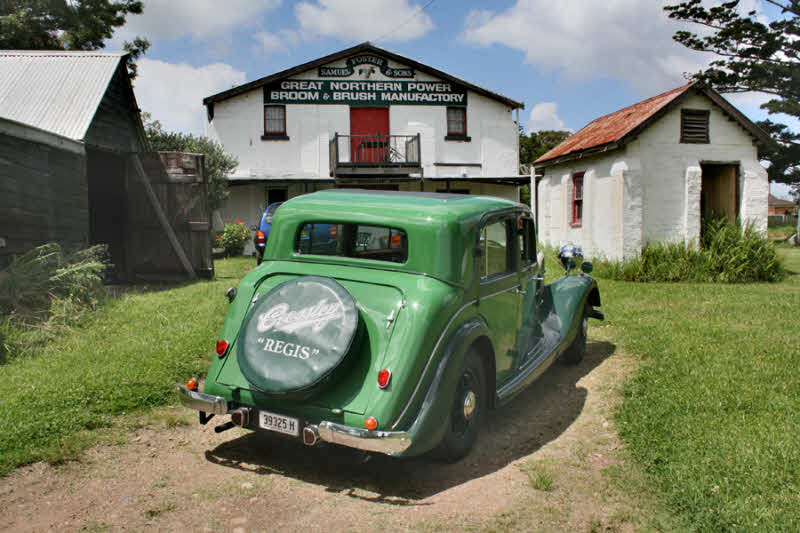
(photos - Peter Caunt)
This Regis with the 10 hp 4-cylinder engine was restored by Peter Caunt. The body is by Ruskin Motor Bodies of Melbourne. No original documents survive but the car is believed to have arrived in Australia in chassis form in 1935. It was thought to be the only surviving Regis in Australia until in 2024 another one was found in Victoria.
Chassis number is 100389 and engine number MC1742.
Peter tells the story of the car's restoration:
This car was advertised in a local Central Coast (of New South Wales, Australia) Car Club newsletter in January 1998. The car was actually described as a "....1932 Crossley, 95% complete, bonnet missing." I answered the advert and went to see the car which was barely a half mile from my home and found a Regis of 1935 with a completely dismantled body and an engine block empty of parts. Of course, I bought it!
On examination, I found that the car was almost complete, apart from bonnet and running boards but that not all the timbers were with the car and those present were of use only as patterns for new timber since they were in a very deteriorated condition, the top and bottom of the offside A-Post having rotted away. All the Lucas lights were missing - since they were used, no doubt, on other projects during the period of storage of the Regis with earlier owners - but most of the body panels were with the car, at least the more complicated shapes which was useful.
Closer inspection as I became more familiar with the car showed that virtually one of everything was missing. It seemed as though the past owner had asked a friend to "get me a set of these" - since a piston and conrod, door exterior handle, window winder, quarter light catch, brake shoes, adjuster and operating levers from one brake drum, the bonnet, running boards and the whole scuttle area which includes the tool boxes under the bonnet. One door lock was missing from the nearside rear door and a different style of lock has had to be fitted here since the original Ruskin style does not appear on swap meets (autojumbles) in this area. The offside brackets which hold the main body sill were missing as was the windscreen surround and glass.
On the plus side, the four doors were complete, if a little tatty and only small repairs were needed to get them into condition to be able to fit the new body frame. Most of the panels were painted in grey primer although odd parts were still in the white that had been used to cover the original dark green colour. During painting to white, a badge had been in place on the nearside scuttle side and had been later removed so that the original green could be seen as well as the badge shape and this helped identify the body as being of Ruskin Motor Body Pty Ltd construction - a fact confirmed by the method of construction of the rear wheel arches where two pieces of one inch square timber had been cut to the shape of the arch and the outer one inch square piece had been trimmed to the vertical shape of the body.
The car varies in several ways from the UK Regis built by Crossley Motors Ltd to the C F Beauvais design. The dashboard and instruments were with the car and the dashboard has glove boxes either side of the instrument panel, unlike the UK cars which have a shelf under the dashboard. The clock has been replaced by a temperature gauge - useful in Australia's temperatures! The handbrake is in the centre of the car whereas the UK cars have this against the offside scuttle. The accelerator pedal is not based on the UK type and had a different connection to the throttle linkage totally unlike the UK cars and not like the earlier Tens. It seems as though Crossley Motors used old stock on these export chassis and left the coachbuilder to work out a suitable linkage! Quarterlights are slightly different in shape from the UK body and the fittings are different. The windows have interior winders, not the "balanced" system of UK cars. The bumper ends are similar to UK designs but the supporting ironwork is different and heavier - more "blacksmithy"! Those from the rear are missing. Track rod ends are a modern type, not sprung and having a modern type grease nipple. (For the record, Armstrong Siddeley Sapphire track rod ends fit the Regis.)
The windscreen surround is of metal rather than the polished timber of the UK cars. The door timbers are to a different pattern not having the diamond shape door pulls of the UK design. The wheels are the usual UK 5.50 X 16 inch wires but with a Crossley Ten wheel disc in the centre whilst the Regis normally has a full Ace Cornercraft disc covering the wheel and an inside plain disc that in effect boxed in the wheel and made it easier to keep the wire wheels clean. At least Australian hot temperatures would allow the brakes to run cooler without the full discs but I doubt that this was the reason for the change - it kept the cost of the imported chassis down! Cars imported to Australia had an import duty added but, to protect the Australian Coachbuilding Industry, an additional tax was imposed over and above the tax on chassis and body which placed the fully imported vehicle at a distinct price disadvantage to Australian made products.
It is possible that the body on this car was built to UK outline - the C F Beauvais design - to let local buyers see what the UK design was but without the added costs of a fully built-up imported car. C F Beauvais worked for several car companies in UK, including Star, Singer and New Avon Body Works Ltd before working for about six months for Crossley Motors as the Coachbuilding Manager. During this time, he cleaned up the Regis design to that based on a Ten chassis (actually the first of the lowered chassis used for the Regis itself) and also designed the larger Three-Litre design for the 1936 Motor Show at Olympia - Crossley's last attendance. He later designed a body for the 26/90 based on the Studebaker Dictator chassis which never got further than the design stage. The Regis was the last model to be "in production" at Gorton.
More information about Mr C F Beauvais is available at the Powerhouse Museum, Sydney.
I had a receipt for the car from the seller but no documents that
gave details of the car. It was, of course, an 1122cc Coventry Climax
engine numbered MC 1742 but there was no sign of the chassis number on
the chassis at the front - or rear, when I looked at that area, having
not found anything near the front. Of the five Regises owned over
forty years ago in UK, I had at least had a log book or the maker's
chassis plate to provide the details. Martin Sims did some work on his
six-cylinder engine in UK and during this work found that the chassis
number is stamped on the flywheel rim so that, provided the engine has
not been changed, gives the chassis number of the car in which it is
fitted. 100392 was within the boundaries 100380 and 100400 in which I
estimated my car to be. Mileage was 53461 and was probably genuine
since it worked for only thirty years, having been taken off the road
in 1965 for rebuilding.
Its history seems to be as follows:
Used by the original owner(s) from 1935 to 1965.
Then purchased from a Sydney suburb by Rod
Richards, a Riley enthusiast who dismantled the rotten body and
on-sold the car in about 1968, having decided to stick to Rileys!
The car was purchased by Jim Scott of Penrith, NSW who stored it- along with several Crossley 15/30 cars - until it was bought by Gary Reberger of Penrith in about 1982 (the year I arrived in Australia but not let us get too excited about that!) and stored it at his father's garage in Umina Beach where I also lived, for his father to do some work on it. This mainly entailed painting the chassis and possibly some investigation work on the car but not a lot of progress was made. Local car enthusiasts had offered to help them to get the body built with figures of $3000 for the wood - a very high figure based on the wood only. The offer had been refused!
I purchased the car on 24th January 1998 and have since restored the car to full running order.
The car was registered on historic number plates
in New South Wales as 37701-H as a member of The Bowthorne Motor Club
of Wallalong, NSW.
In October, 2009, the correct chassis plate was
found for the car via Motorden, a Brisbane eBay dealer. This was
purchased and fitted to the car – the Chassis number being 100389. The
car was re-registered in January 2010 to include the new number as
39325 – H.
In 2021 Peter sold the car to Shane Perrott in Victoria where it joins his 15/30.